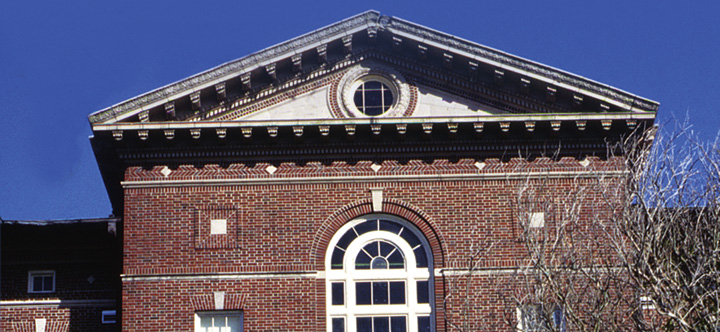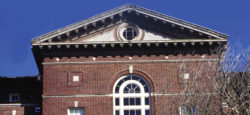Fall 2006
A Feminine Perspective
Louisiana boasts many 19th and 20th-century buildings influenced by women
Published: March 20, 2015
Last Updated: January 11, 2019

The Baroness Micaela Almonester Pontalba’s financing of her eponymous apartment houses that flank New Orleans’ Jackson Square is perhaps Louisiana’s most well-known example of a woman who created some of the state’s most handsome buildings. And her directives to her architects in the design of the apartments certainly influenced how they were built.
Women have influenced Louisiana’s architecture by other means too. The pioneers for historic preservation are a case in point. It was women who took the first steps in the restoration of the Vieux Carré. One of the goals of the New Orleans’ women’s organization known as Le Petit Salon was “to keep and preserve old historic buildings.” Many historic buildings in the state exist today because women organized to save them from demolition.
In many ways, women have been instrumental in seeing that buildings were born or survived, although these ways are often less visible or recognized.
Take, for example, women’s clubs. For men, clubs were a retreat from the world; for women, they were, and often still are, a step into it. From the middle part of the 19th century, women joined together for social and intellectual pleasures at a time when their roles were highly restricted and opportunities limited. In many of these clubs, the members made civic responsibility and public welfare central to their mission. Some pushed for the enforcement of sanitation and health ordinances, while others advocated on behalf of the aged and homeless, established programs to help young professional women, lobbied for parks and city beautification, and established libraries
Libraries were foremost among the activities that women’s clubs sponsored. By the late 19th century, club members throughout the state had collected books and made them available either by private subscription or open to the community. Some established a reading room in the home of one of the members.
In 1885, a group of women formed a library in Jennings, a town founded only four years previously as a stop on the Southern Pacific Railroad. In 1889, the women purchased a house in downtown Jennings (now demolished) to accommodate their growing library. Their minutes record that “So many northern homesteaders were pouring in [to the area] each week and came into Jennings for weekends with nowhere to go and little to see, that a reading room and library were necessary to their comfort.” Upon hearing that steel magnate Andrew Carnegie was making gifts to libraries, these enterprising women requested funding for a new building, although, as was typical of the time for financial dealings, one of the member’s husbands was obliged to undertake the negotiations. With a donation from Carnegie of $10,000, the women got a handsome structure with a classical portico and domed entrance vestibule designed by the New York firm of Whitfield and King, which opened in 1908.
Carnegie money funded libraries throughout the state and supported the Louisiana Library Commission’s (later the State Library) program to open public libraries in rural areas. The Commission’s first project was in Rayville, which was selected because its women’s club had already established a membership library. The library occupied its new building in 1927, which was named for Nonnie Roark Rhymes, a deceased member of the library’s board of directors. The simple one-story rectangular building of red brick with white trim and delicate architectural details blends with its residential neighborhood.
Tallulah’s public library has its roots in the Tallulah Literary Club, established by a group of local women in 1902. First accommodated in one of the member’s homes, the lending library had grown so large by the 1920s that the women commissioned a building to house it. Constructed in 1930 to a design by architect William Stanton, the stucco-covered brick Spanish Colonial Revival structure made a bold statement in this small town with its curved parapet, scroll-shaped buttress marking the entrance, and blue tiles decorating the entrance vestibule. The building survives, though it now has a different owner, and the parish library occupies another building.
While most women’s clubs purchased an already existing building in which to hold their meetings and activities, some commissioned an entirely new clubhouse. With a building of their own, the women could distinctly announce their presence and importance to the community.
The Woman’s Department Club in Shreveport was organized in 1919 and within a handful of years commissioned architect Clarence King to design a building for their many programs. Completed in 1925, the two-story clubhouse’s rectangular outline, red brick exterior, columned porticoes, and pitched roof convey almost a domestic image, as was typical of many buildings designed specifically for the use of women in the first half of the 20th century. The first floor echeos the homelike qualities for the rooms were labeled on the architect’s plans as dining room, living room, kitchen, and hall. The second floor was devoted to an auditorium and stage.
In Louisiana’s segregated society of the first half of the 20th century, African-American women formed their own organizations to meet their social and professional needs, and that of their communities. One was Shreveport’s Court of Calanthe whose members built a temple to hold their events. Built in 1923, the four-story building is enhanced by Corinthian pilasters and a pediment over the entrance door. The variegated color of the brickwork gives a tapestry-like effect to the walls. No longer occupied by the organization, the building awaits restoration and a new use.
The Bernice Civic Clubhouse, constructed in 1938 and sponsored by the Bernice women’s organization, incorporated a large meeting room for community events. The one-story wooden building’s rustic appearance perfectly suits its rural location. But it is interesting to see that many buildings designed specifically for women’s use were built from red brick, with white trim, and architectural details in the Colonial Revival style as in the Shreveport Woman’s Department Club building. Architects and the public alike considered the style as appropriately feminine, perhaps because of its associations with Colonial domestic architecture, and certainly because of its delicacy.
The most obvious example of this style is exhibited at Newcomb College on the campus of Tulane University in New Orleans. Funded by Josephine Newcomb in memory of her deceased daughter, Newcomb’s buildings were planned to reflect their female occupants. The competition for the school’s design was won by James Gamble Rogers of New York because, according to the judges, his design had “the refinement, simplicity and charm fitting for women in the South.” The small-scaled porticoes, detailing and the white trim on the red brick buildings are modest indeed.
Markedly different in style and materials are the log cabins that make up the rural Germantown colony near Minden. Few places in the nation can boast a communal colony founded by a woman, but Louisiana can. The colony was founded in 1836 by Elisa Mueller, also known as the Countess von Leon. Emigrating from Germany in 1830 with her husband, the religious leader Bernhard Mueller (who called himself the Count von Leon), and their followers, the group settled first with George Rapp’s colony at Economy, Pennsylvania. Following the Count’s death from yellow fever in 1834, Elisa and her group moved to North Louisiana. Their community was made up of several houses, a communal kitchen-dining room, a general store, a school, barns and workshops. Although the commune disbanded in 1871, several buildings survive, including the countess’s simple two-room log house with its gallery across the front.
Women always have expressed themselves in a variety of creative ways to shape and sustain their communities. From the 19th century, they increasingly found new means to make their imprint, and not least on Louisiana’s architecture.
—–
Karen Kingsley, Ph.D., is professor emerita of architecture at Tulane University, author of Buildings of Louisiana (2003, Oxford University Press), and a free-lance writer. This architecture column appeared in the Fall 2006 edition of Louisiana Cultural Vistas.
